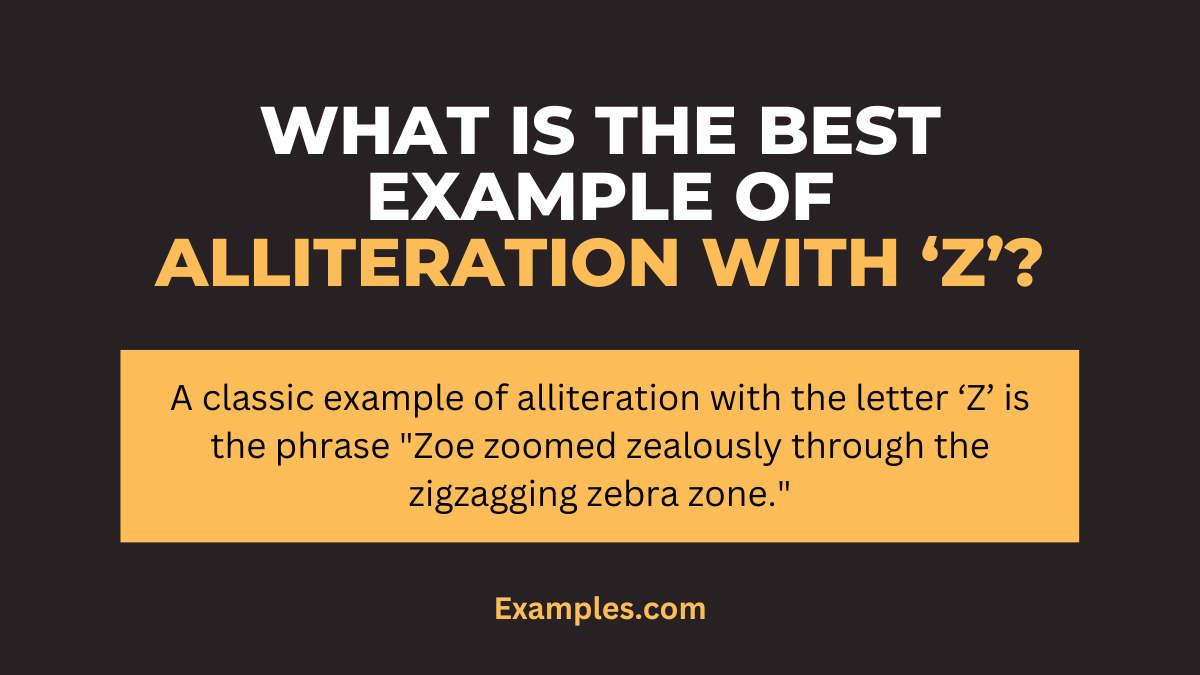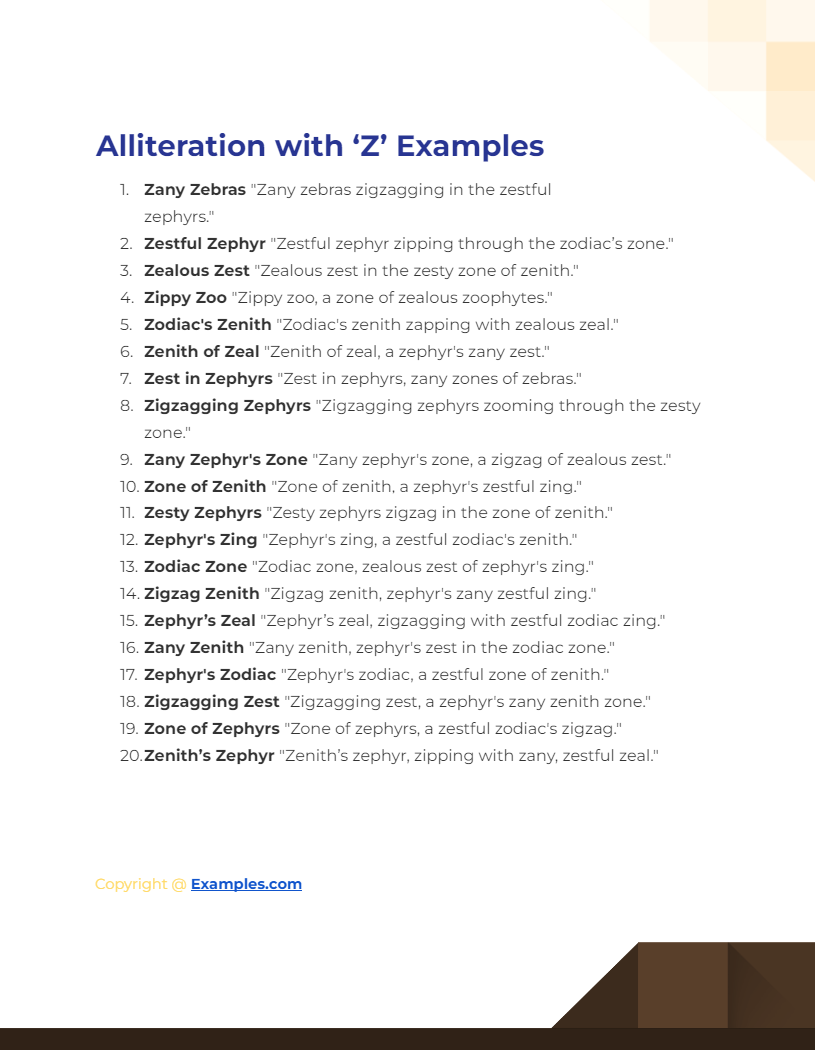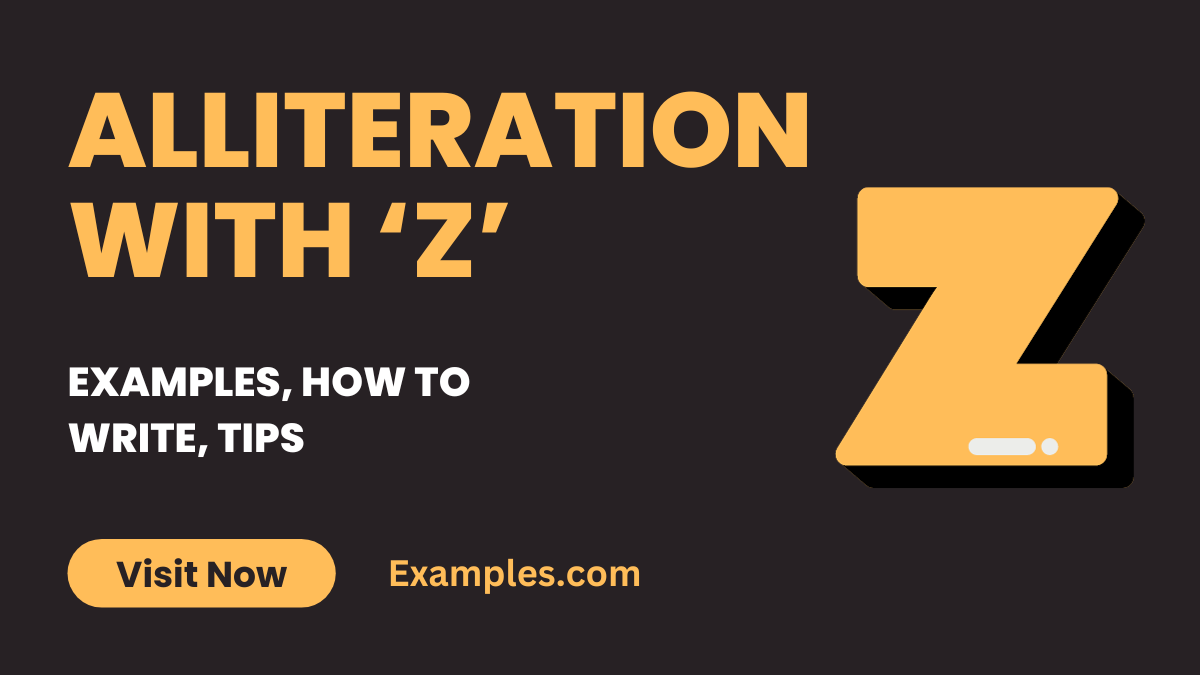19+ Alliteration with Z Examples
Unlocking the art of alliteration with the elusive letter ‘Z’ can be both challenging and creatively rewarding. This article delves into the world of ‘Z’ alliteration, offering a delightful array of examples, expert tips, and a guide on how to master this linguistic technique. Whether you’re a writer seeking to add zest to your prose or a wordplay enthusiast looking for zealous inspiration, our exploration of ‘Z’ famous alliteration has you covered. Let’s embark on this zany linguistic adventure!
Download Alliteration with 'Z' Examples
Download Alliteration with 'A' to 'Z' Examples
What is the Best Example of Alliteration with ‘Z’?

Example: A classic example of alliteration with the letter ‘Z’ is the phrase “Zoe zoomed zealously through the zigzagging zebra zone.”
Meaning: Alliteration is a literary device that involves the repetition of the same initial consonant sound in a series of words within a sentence or phrase. In the example, “Zoe zoomed zealously through the zigzagging zebra zone,” the consonant ‘Z’ is consistently repeated at the beginning of multiple words. This creates a sense of rhythm and musicality in the sentence. Easy Alliteration is often used in poetry, literature, and tongue twisters to add emphasis, create memorable phrases, and enhance the overall sound and texture of language.
20 Alliteration with ‘Z’ Examples

Download Alliteration with 'Z' Examples in PDF
Alliteration with the letter ‘Z’ creates zealous zephyrs of zestful and zany zest, offering an exotic and often zippy auditory experience. The ‘Z’ sound, known for its zest and sometimes zany quality, is perfect for crafting hard alliteration examples. Especially effective in alliteration in rhymes, the ‘Z’ sound adds an energetic and engaging dimension to verses. Here are 20 unique examples of alliteration with ‘Z’, each complemented by a rhyme title that encapsulates the essence of the phrase.
- Zany Zebras “Zany zebras zigzagging in the zestful zephyrs.”
- Zestful Zephyr “Zestful zephyr zipping through the zodiac’s zone.”
- Zealous Zest “Zealous zest in the zesty zone of zenith.”
- Zippy Zoo “Zippy zoo, a zone of zealous zoophytes.”
- Zodiac’s Zenith “Zodiac’s zenith zapping with zealous zeal.”
- Zenith of Zeal “Zenith of zeal, a zephyr’s zany zest.”
- Zest in Zephyrs “Zest in zephyrs, zany zones of zebras.”
- Zigzagging Zephyrs “Zigzagging zephyrs zooming through the zesty zone.”
- Zany Zephyr’s Zone “Zany zephyr’s zone, a zigzag of zealous zest.”
- Zone of Zenith “Zone of zenith, a zephyr’s zestful zing.”
- Zesty Zephyrs “Zesty zephyrs zigzag in the zone of zenith.”
- Zephyr’s Zing “Zephyr’s zing, a zestful zodiac’s zenith.”
- Zodiac Zone “Zodiac zone, zealous zest of zephyr’s zing.”
- Zigzag Zenith “Zigzag zenith, zephyr’s zany zestful zing.”
- Zephyr’s Zeal “Zephyr’s zeal, zigzagging with zestful zodiac zing.”
- Zany Zenith “Zany zenith, zephyr’s zest in the zodiac zone.”
- Zephyr’s Zodiac “Zephyr’s zodiac, a zestful zone of zenith.”
- Zigzagging Zest “Zigzagging zest, a zephyr’s zany zenith zone.”
- Zone of Zephyrs “Zone of zephyrs, a zestful zodiac’s zigzag.”
- Zenith’s Zephyr “Zenith’s zephyr, zipping with zany, zestful zeal.”
Alliteration Sentence Examples with ‘Z’
Alliteration sentence examples with ‘Z’ often add a zesty or zippy quality to the text, utilizing the unique ‘Z’ sound to create an engaging and dynamic narrative. This type of alliteration is relatively rare and can bring a distinctive flair to literary works, including alliteration in poems, songs, and movies. Here are three examples:
- “Zelda’s zinnias bloomed zealously in the zephyr-filled zone.”
- “Zachary’s zebra zigzagged zestfully across the zoo.”
- “Zoe zoomed in her zippy zephyr on the zigzagging zenith.”
Alliteration Examples with ‘Z’ Words
Alliteration examples using ‘Z’ words demonstrate the consonant’s ability to create intriguing, memorable phrases. These examples are often employed in alliteration in songs, where the ‘Z’ sound adds a lively, engaging element. Here are three examples:
- “Zany zeppelins zoomed zealously above the zodiac.”
- “Zara’s zither zinged with zestful, zippy tunes.”
- “Zealous zoologists zealously zoned in on the zebrafish.”
Alliteration Poem with ‘Z’
An alliteration poem with ‘Z’ uses the repetitive ‘Z’ sound to create a rhythmically and aesthetically engaging poetic experience. Alliteration in poems, especially with the ‘Z’ sound, brings forth a unique lyrical quality. Here are three examples:
- “Zesty zephyrs zoom, / Zigzagging through the room.”
- “Zebras in the zoo, / Zigzagging, black and white in hue.”
- “Zinnias in the breeze, / Zigzag and dance with ease.”
Alliteration Beginning with ‘Z’
Alliteration beginning with ‘Z’ sets a specific tone and rhythm in a phrase, often creating an extraordinary and impactful auditory experience. Found in various artistic expressions, including alliteration in movies, it adds a distinctive flair. Here are three examples:
- “Zara’s zestful zeal zinged in the zany zone.”
- “Zephyrs zigzagged zealously in the zenith’s zone.”
- “Zelda zipped her zipper with zero zest yesterday.”
How to Write Alliteration with ‘Z’?
Creating alliteration with the letter ‘Z’ involves the strategic placement of words that start with the ‘Z’ sound in close proximity within sentences or phrases. The ‘Z’ sound, known for its zest and uniqueness, can add an energetic and dynamic rhythm to your writing. This technique is employed across various contexts, from educational materials like alliteration for first grade to more complex alliteration in figurative language. Here’s how to craft effective alliteration with ‘Z’:
- Understand the ‘Z’ Sound: Familiarize yourself with the ‘Z’ sound. It’s a consonant that can bring energy and a distinctive quality to your writing.
- Select a Theme or Concept: Choose a theme or subject. This helps in finding relevant ‘Z’ words that fit your topic, whether you’re crafting alliteration with answers or for creative expression.
- Brainstorm ‘Z’ Words: Make a list of words that start with ‘Z’. Include a variety of words (nouns, verbs, adjectives) to enrich your alliteration.
- Formulate Your Phrase or Sentence: Construct a sentence or phrase using your chosen ‘Z’ words. Strive for a natural flow that accentuates the alliterative effect.
- Read Aloud for Rhythm: The effectiveness of alliteration is often best judged audibly. Read your sentence aloud to ensure it has a pleasing rhythm.
- Revise for Clarity and Impact: Ensure your alliterative phrase is clear and contributes effectively to your overall message or story.
- Apply in Various Contexts: Whether it’s in alliteration figurative language exercises, as part of teaching alliteration for first grade, or in creative writing, adapt your use of ‘Z’ alliteration to suit the purpose and audience.
Tips for Using Alliteration with ‘Z’
Here are the Tips for Using Alliteration with ‘Z’:
- Use Sparingly: Given the rarity of ‘Z’ words, use this alliteration judiciously to avoid overwhelming your text or making it feel unnatural.
- Maintain Relevance: Ensure that your ‘Z’ alliteration is relevant to your topic or story. Avoid forcing ‘Z’ words into your writing where they don’t fit naturally.
- Consider Your Audience: Tailor your alliteration to your audience. For alliteration of first grade, use simpler ‘Z’ words and concepts, whereas for adults, you can explore more complex ‘Z’ alliterations.
- Balance with Other Words: Since ‘Z’ words are less common, balance them with other words to maintain the flow and coherence of your writing.
- Explore Different Forms: Try ‘Z’ alliteration in various forms of writing. It can add a unique twist to poetry, stories, and even academic or promotional writing.
- Review and Refine: Read your work aloud, refine it, and make sure it achieves the desired alliterative effect without compromising the content’s quality.
Alliteration with ‘Z’ can add an intriguing and distinctive element to your writing, making it stand out and captivate your audience.
What are the Alliteration Tongue Twisters with ‘Z’?
Alliteration tongue twisters with ‘Z’ are phrases designed to challenge pronunciation, focusing on the repetition of the ‘Z’ sound. These tongue twisters are not only fun but also serve as excellent exercises for speech clarity and pronunciation practice in alliterative literature, suitable for learners of all ages. Here are some examples:
- “Zany zebras zigzagged through the zesty zinnia zones.”
- “Zelda zipped zippers zealously in the zephyr’s breeze.”
- “Zigzagging zeppelins zoomed over the zoo’s zodiac zone.”
These tongue twisters can be both entertaining and educational, aiding in language development and speech skills.
What are the Alliteration with ‘Z’ for Kids?
Alliteration with ‘Z’ for kids involves creating simple, engaging, and often humorous phrases that are easy for children to understand and enjoy. These alliterations help in developing phonetic awareness and making learning fun. Examples tailored for alliteration for kids include:
- “Zach’s zippy zebra zoomed around the zoo.”
- “Zoe and Zara saw zebras zigzagging in the zone.”
- “Zachary’s zany zoo zapped with zesty zeal.”
These examples focus on simplicity and fun, making them ideal for children’s language learning and entertainment.
What is the Effect of ‘Z’ Letter in Alliteration?
The effect of the ‘Z’ letter in alliteration is to create a vibrant, sometimes zany sound that adds a lively and energetic quality to language. The ‘Z’ sound, being a voiced fricative, has a buzzing and pronounced quality, making it effective for drawing attention to specific phrases and enhancing the rhythmic quality of the text. In literature, ‘Z’ alliteration is often used to set a particular mood or to add a dynamic quality to the narrative. Its versatility makes it significant in both alliteration for kids and more sophisticated works alliteration for adults. The ‘Z’ sound plays a substantial role in both alliteration and assonance, contributing to the overall sonic appeal of a piece.
What is the Alliteration ‘Z’ Type of?
Alliteration with the letter ‘Z’ is a type of consonantal alliteration, where the consonant sound at the beginning of adjacent or closely connected words is repeated. This type of alliteration is relatively rare and can be quite effective due to the distinctiveness of the ‘Z’ sound. The ‘Z’ type of alliteration can create different effects, from energetic and playful to more forceful and pronounced, depending on the context and the words chosen. This form of alliteration and assonance is seen in a wide range of literary works and is a favorite in educational materials for its appeal and effectiveness, widely used in alliteration for students and alliteration for kids. The ‘Z’ alliteration’s ability to add a dynamic and rhythmic quality to writing makes it a versatile tool for writers and educators.


